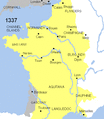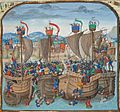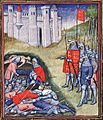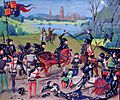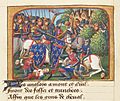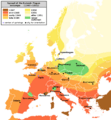Hundred Years' War facts for kids
Quick facts for kids Hundred Years' War |
|||||||||
|---|---|---|---|---|---|---|---|---|---|
| Part of the Anglo-French Wars | |||||||||
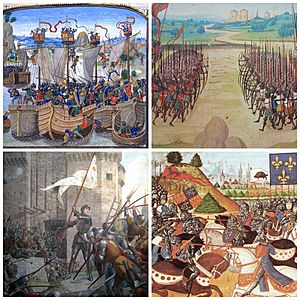 Clockwise, from top left: The Battle of La Rochelle, The Battle of Agincourt, The Battle of Patay, Joan of Arc at the Siege of Orléans |
|||||||||
|
|||||||||
| Belligerents | |||||||||
|
|
||||||||
| Commanders and leaders | |||||||||
|
|
||||||||
The Hundred Years' War was a long conflict between France and England. It happened during the late Middle Ages, lasting 116 years from 1337 to 1453. The war started because Charles IV of France died in 1328 without a son to take his place.
Edward III of England believed he should be the new king of France. He was Charles IV's nephew through his mother. However, the French did not want a foreign king. So, Philip VI of France became king. He argued that, by Salic law, women could not rule or pass on the right to rule to their sons. This disagreement led to war between the two countries.
Contents
The Start of the War (1337-1360)
At the beginning, France was stronger than England. France had more people and was wealthier. French knights were also famous for their fighting skills across Europe. France had about 17 million people, while England had only about 4 million.
However, France was not as unified as England. It was a feudal monarchy, meaning power was spread out among many lords. France was allied with Scotland and Bohemia. England had support from parts of the Low Countries and some areas in France.
Early English Victories
England won an important naval battle at the Battle of Sluys in 1340. This stopped France from invading England by sea. After this, most of the fighting took place in France.
England then won a huge victory at the Battle of Crécy in 1346. The English used their powerful longbow archers and sharp stakes to stop the French cavalry. This was a surprising win against a larger French army.
The Black Death and Truce
From 1348 to 1356, there was little fighting. This was because of the Black Death, a terrible plague. It killed many people in both England and France.
After the plague, Edward, the Black Prince (Edward III's son) won another great victory for England. This was at the Battle of Poitiers. During this battle, King John II of France was captured. The English tried to invade France again but could not capture more cities. A peace agreement in 1360 gave England control over about one-quarter of France. This first part of the war is known as the Edwardian War.
France Fights Back (1369-1415)
The war began again in 1369. The new French king, Charles V of France, was more successful. He had a very skilled knight named Bertrand du Guesclin. France also formed an alliance with Castile. They fought against England and Portugal. Some battles even happened in Spain and Portugal.
During this time, France won back most of the land it had lost to England. Bertrand du Guesclin led French forces to important victories at the battles of Cocherel and Pontvallain. A period of peace then followed from 1389 to 1415. This second part of the war is called the Caroline War.
Joan of Arc and the French Victory (1415-1453)
The most famous part of the war started in 1415. Henry V of England invaded France. He won a very important battle at Agincourt. His longbowmen were key to this victory. Many French nobles were killed in that battle.
At this time, King Charles VI of France was very unwell and could not rule. Most of his sons had died young. The French queen, Isabeau of Bavaria, arranged for her daughter to marry Henry V. She also signed the Treaty of Troyes. This treaty said that Henry V would be the next king of France.
Both Henry V and Charles VI died around the same time in 1422. So, the English believed Henry V's son, Henry VI of England, was the rightful king of France. Many French people agreed. However, Charles VI's last son, Charles VII of France, said he should be the new king.
The Rise of Joan of Arc
The English continued to take more land in France. They also made an alliance with Burgundy, a powerful French state. The English won another major battle at the Battle of Verneuil.
But in 1429, a young woman named Joan of Arc changed everything. She led the French army to a big success at the Siege of Orleans. Then, at the Battle of Patay that same year, French knights won a great victory. They defeated many experienced English longbowmen.
Joan helped France take back many cities in the north-east. She also helped Charles VII get crowned as king. However, she did not manage to take back Paris. Joan was captured by the Burgundians in 1430. She was later found guilty of heresy and burned at the stake in 1431.
France's Final Push
Even after Joan's death, the French kept taking back their territory. France also had a big diplomatic win in 1435. This was with the Treaty of Arras. In this treaty, Burgundy stopped being England's ally and made peace with France.
In 1450, France won another great victory at the Battle of Formigny. They then took back the region of Normandy. The war finally ended in 1453 with a huge French victory at the Battle of Castillon. In this battle, nearly 300 cannons were used for the first time. This last part of the war is called the Lancastrian War.
Images for kids
-
Homage of Edward I of England (kneeling) to Philip IV of France (seated), 1286. As Duke of Aquitaine, Edward was also a vassal to the French King.
-
Battle of Sluys from a BNF manuscript, c. 1470.
-
Battle of Crécy, 1346, from the Grandes Chroniques de France.
-
Edward III counting the dead on the battlefield of Crécy.
-
Black Monday (1360), hailstorms and lightning hit the English army at Chartres.
-
Statue of Bertrand du Guesclin in Dinan.
-
Fifteenth-century picture depicting the Battle of Agincourt of 1415.
-
The first Western image of a battle with cannon: the Siege of Orléans in 1429.
-
Joan of Arc (picture 1429).
-
The Battle of Formigny (1450).
-
The spread of the Black Death (with modern borders).
See also
 In Spanish: Guerra de los Cien Años para niños
In Spanish: Guerra de los Cien Años para niños



